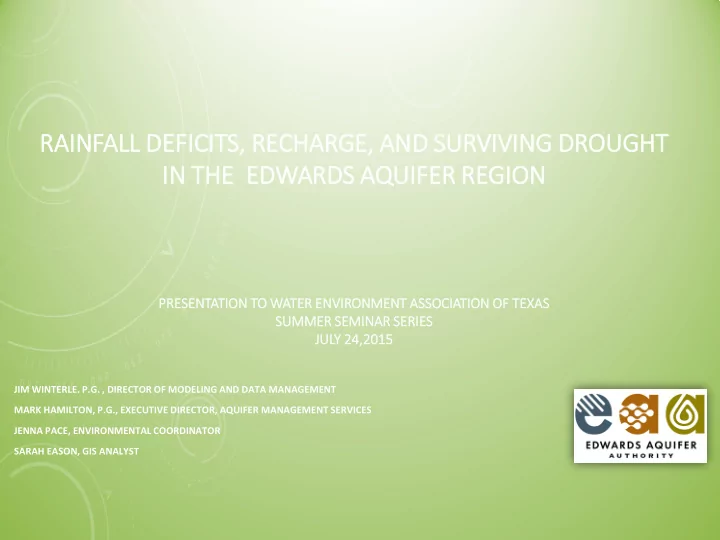

RAIN INFALL D DEFICIT ITS, R RECHARGE, A AND SU SURVIV IVIN ING D DROUGHT IN N THE EDWARD RDS A AQU QUIFER R R REGION PRESENT NTATION ON T TO WATER E ENVIRONM ONMENT NT ASSOC OCIATION ON O OF T TEXAS SUMME MMER S SEMI MINAR S SERIES JULY LY 24, 24,2015 2015 JIM WINTERLE. P.G. , DIRECTOR OF MODELING AND DATA MANAGEMENT MARK HAMILTON, P.G., EXECUTIVE DIRECTOR, AQUIFER MANAGEMENT SERVICES JENNA PACE, ENVIRONMENTAL COORDINATOR SARAH EASON, GIS ANALYST
Assessing Rainfall Deficit from 2003-2014 • At beginning of 2015, drought maps showed widespread improvements in drought conditions in Central Texas, but groundwater levels remained low. • Questions about why recharge has been far below average when rainfall was near average for the past two years • Summary of rainfall deficits, annual recharge, and water levels January 1, 2003 – December 31, 2014.
Background This map shows the EAA precipitation gauging network. Over 70 automated gauges • Data used to calibrate NEXRAD • Calibrated NEXRAD data used • for detailed region wide rainfall totals
Expected Rainfall for a 12-Year Period Based on NWS 30-year Average from 1981-2010
2003 to 2014 Actual Rainfall
12-year Cumulative Deficit
Regional Mean Statistics Compared to a regional mean annual rainfall of 30” an 82” deficit equates to: Missing 2.7 Years of rainfall for the period. Compared to a regional mean annual rainfall of 30” A worst case deficit (-130”) equates to: Missing 4.3 years of rainfall over the 12-year period.
Deficit Rainfall Statistics, 2003-2014 Including Drought of Oct. 2010 to Sept. 2011
Although the Drought Maps Show Improvements in Recent Months Water Levels Do Not
Annual Rainfall Deficit Index Well Water Levels Annual Recharge
In the most recent 12-year period, 7 of the years are below average. Over 50-percent of the total recharge for this period occurred in 2004 and 2007. 4.3 million AF (2004 and 2007) 3.6 million AF (remaining years) Recharge 2003-2014 Mean = 660,500 Median = 263,200 Recharge 1934-2014 Mean = 692,100 AF Median = 556,100 AF
Differences in Recharge Between Years 2011 and 2014 The cumulative effect of contiguous dry years impacts stream flows which impacts recharge. More rigorous analyses of recharge is underway using Puente and HSPF.
2015 Recovery from the Drought Rainfall totals for January-June, 2015
2015 Recovery from the Drought
2015 Recovery from the Drought
Conclusion Regional rainfall deficits are quite significant over the twelve year period 2003 – • 2014, averaging -82 inches across the Edwards Aquifer region. The regional mean rainfall deficit for the period 2008 – 2014, is -71 inches. • (Equivalent to 2.3 out of 7 years with no rainfall based on a 30-inch annual mean) Cumulative deficit can reduce annual recharge to far below average even when • rainfall is only slightly below average Timing and location of rainfall is also important to recharge • Recovery of aquifer levels in 2015 shows that we don’t need to make up the all of • the cumulative deficit to get good recharge Total long-term recharge to the aquifer tends to be dominated by relatively few • wet years Conservation measures under EAA Act have helped to sustain water levels through • the recent drought
Recommend
More recommend